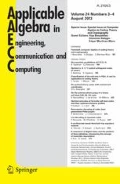Abstract
Since Fellows and Koblitz introduced the generic combinatorially algebraic public-key cryptosystem Polly Cracker in 1993, the question whether there exist secure and efficient instances of Polly Cracker remains unsettled. Namely, many of these schemes succumb to the Linear-Algebra Attacks by D. Naccache et al. and Lenstra. In this paper I present a public-key cryptoscheme Polly Two that is efficient and in some way a modified Polly-Cracker instance, but comprises techniques defending the linear-algebra attacks.
Similar content being viewed by others
References
Bao, F., Deng, R., Geiselmann, W., Schnorr, C., Steinwandt, R., Wu, H.: Cryptanalysis of two sparse polynomial based public key cryptosystems. In: Public key cryptography 2000. Lecture Notes in Comput Sci pp. 153–164, 1992. Springer, Berlin Heidelberg New York (2001)
Becker, T., Weispfenning, V.: Gröbner bases. A computational approach to commutative algebra. In cooperation with Heinz Kredel. Graduate Texts in Mathematics, 141. Springer, Berlin Heidelberg New York (1993)
Barkee, B., Can, D.C., Ecks, J., Moriarty, T., Ree, R.F.: Why you cannot even hope to use Gröbner bases in public key cryptography: an open letter to a scientiest who failed and a challenge to those who have not yet failed. In: J Symbol Comput (18), 497–501 (1994)
Eisenbud, D.: Commutative algebra. With a view toward algebraic geometry. Graduate Texts in Mathematics, 150. Springer, Berlin Heidelberg New York (1995)
Endsuleit R., Geiselmann W., Steinwandt R. (2002). Attacking a polynomial based cryptosystem: Polly Cracker. Int J Inform Secu 1(3):143–148
Fellows M., Koblitz N. (1992). Combinatorial cryptosystems galore! Finite fields: theory, applications, and algorithms (Las Vegas, NV, 1993). Contemp Math 168:51–61
Geiselmann W., Steinwandt R. (2002). Cryptanalysis of Polly Cracker. IEEE Trans Inform Theory 48(11):2990–2991
Grant, D., Krastev, K., Lieman, D., Shparlinski, I.: A public key cryptosystem based on sparse polynomials. In: Proceedings of International Conference on coding theory, cryptography, and related areas, Guanajuato, pp. 114–121. Springer, Berlin Heidelberg New York (2000)
Grassl, M., Steinwandt, R.: Breaking a Polly-Two challenge. Private communication, (2004)
Huynh D. (1986). A superexpoential lower bound for Gröner bases and Church-Rosser commutative Thue systems. Inform Control 68(1–3):196–206
Koblitz N. (1998). Algebraic aspects of cryptography. Algorithms and Comput Mathe, 3. Springer, Berlin Heidelberg New York
Ly, L.: Polly Two – a public-key cryptosytem based on Polly Cracker. Dissertation, Ruhr-Universität Bochum (2002). http://www-brs.ub.ruhr-uni-bochum.de/netahtml/HSS/Diss/ LyLeVan/
Author information
Authors and Affiliations
Corresponding author
Rights and permissions
About this article
Cite this article
Van Ly, L. Polly Two : A New Algebraic Polynomial-based Public-Key Scheme. AAECC 17, 267–283 (2006). https://doi.org/10.1007/s00200-006-0010-0
Received:
Published:
Issue Date:
DOI: https://doi.org/10.1007/s00200-006-0010-0




